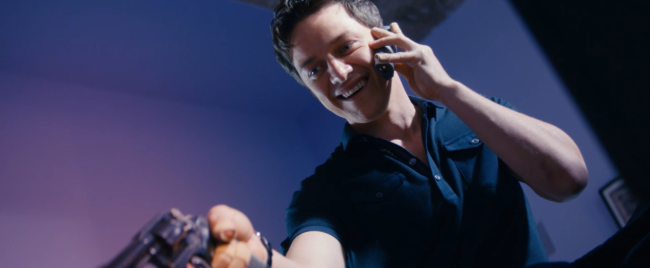Things are not what they seem in Danny Boyle’s new psychological thriller, a daring and spellbinding dive into the realm of the subconscious. James McAvoy is Simon, an art auctioneer who bands up with a group of criminals to steal a priceless painting from his own auction house. A blow to the head during the theft renders Simon unconscious, and upon awakening he finds that he has stolen the painting himself and has no recollection of what he’s done with it. Torturing Simon for the information proves to be fruitless, so the gang’s leader Franck (Vincent Cassel) forces Simon to turn to hypnosis to unlock the memory of the painting’s location. Enter Elizabeth Lamb (Rosario Dawson), a hypnotherapist who discerns Simon’s dangerous situation with uncanny acuity and takes it upon herself to get involved. “I can help you,” she writes on a notecard so that only Simon can see.
Whether she really can / will help, however, is not readily apparent. Elizabeth is a proficient hypnotherapist, and Simon proves to be particularly susceptible to hypnosis, slipping into trances within minutes. But as Elizabeth adds more and more caveats to the process of finding the painting, the men begin to wonder about her motives. We find ourselves wondering too.
The claustrophobic, kaleidoscopic world Boyle creates here is captivating. The cast is small, the story revolving almost exclusively around Simon, Elizabeth, Franck, and Franck’s two thugs Nate (Danny Sapani) and Riz (Wahab Sheikh), and as the plot races towards its climax it twists tightly inwards rather than expanding outwards. The characters reveal themselves to have unexpected dimensions and ulterior motives, and their relationships prove to be the crux of unlocking Simon’s memory.
 Out of all of the characters, Elizabeth is particularly unusual. Calm and stoic, she dresses primarily in trousers, blouses, and blazers and keeps her hair pulled back in a simple braid. In a conversation in which a violent ex-boyfriend of hers is mentioned, she says placidly, “To be angry is to be a victim. I’ve moved on. That’s the only real victory.” It’s not altogether clear whether her stoicism is genuine, but regardless, Elizabeth has a real advantage over her fellow male characters due to her seeming ability to keep a cool head and her knowledge of psychotherapy. Her profession provides her with the tools to render people utterly vulnerable, and she uses that to her advantage, peering into the other characters’ minds while keeping her own thoughts obscure.
Out of all of the characters, Elizabeth is particularly unusual. Calm and stoic, she dresses primarily in trousers, blouses, and blazers and keeps her hair pulled back in a simple braid. In a conversation in which a violent ex-boyfriend of hers is mentioned, she says placidly, “To be angry is to be a victim. I’ve moved on. That’s the only real victory.” It’s not altogether clear whether her stoicism is genuine, but regardless, Elizabeth has a real advantage over her fellow male characters due to her seeming ability to keep a cool head and her knowledge of psychotherapy. Her profession provides her with the tools to render people utterly vulnerable, and she uses that to her advantage, peering into the other characters’ minds while keeping her own thoughts obscure.
Elizabeth becomes more sympathetic as we find out more about her, while Simon becomes less and less likable. McAvoy breaks out of his typically sweet and sensitive roles here, giving a performance that is guarded, nuanced, and at times explosive. And indeed, by the end of the film Elizabeth has essentially hijacked the narrative from him; we begin with Simon’s voiceover and follow him as our main character, but by the end he becomes simply a feature of Elizabeth’s story.
As the film progresses, the line between trance and reality begins to blur. Boyle’s cinematography enhances this disorientation: the plentiful mirrors and large panes of glass create fragmented and multiplied reflections, and give characters vantage points over one another. Even in the safety of an apartment, there is a sense of inescapable voyeurism — as if each character is in his/her own private panopticon.
Through this tortuous narrative, Boyle strips his characters down to reveal their greed and perversion as well as their tenderness and vulnerability. And while the film is dark and real, it isn’t altogether bleak; it’s simply human. Trance peers into the depths of the mind and does not flinch at what it finds there, and for that it should be commended.

